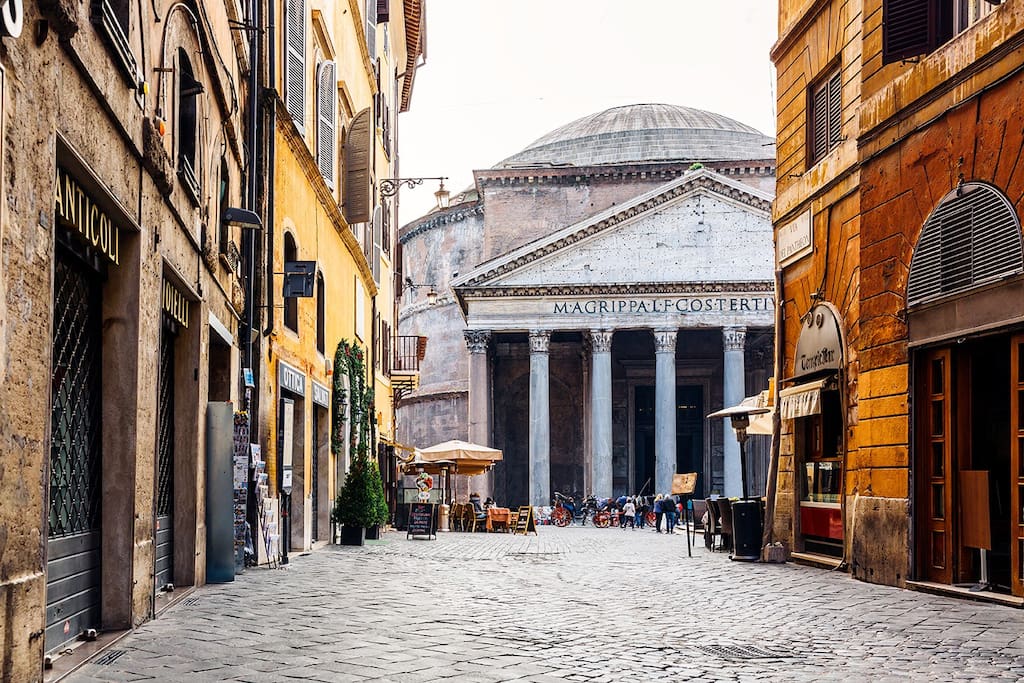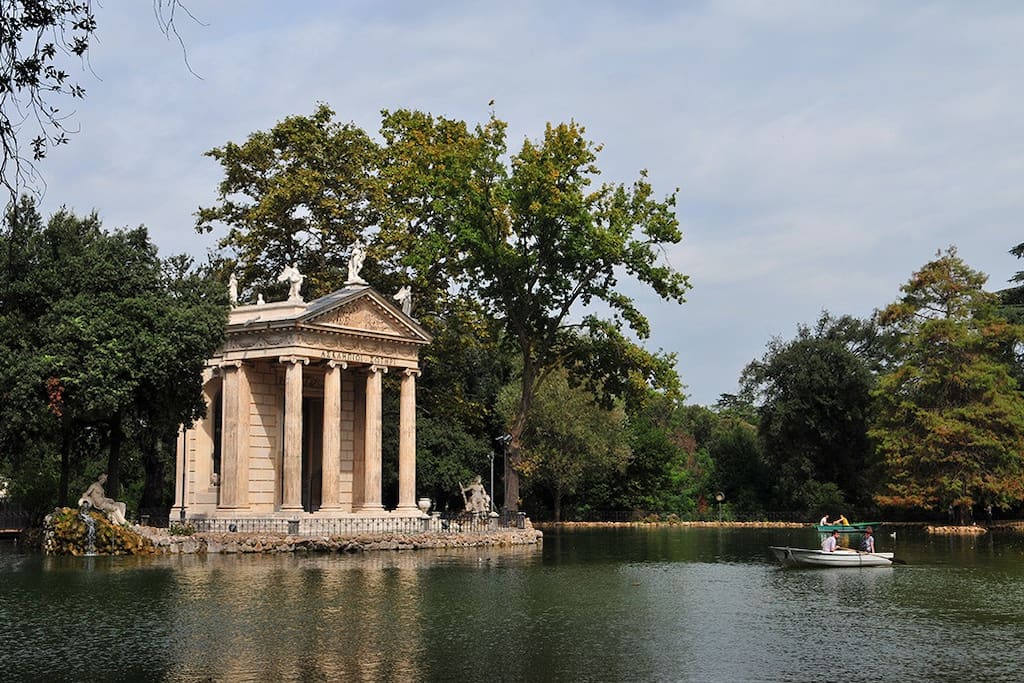Sightseeing
Barberini Square is one of the most important Roman squares.the Triton Fountain is one of the most elegant Bernini's works and among the most appreciated fountains in Rome
77 当地人推荐
Piazza Barberini
Piazza BarberiniBarberini Square is one of the most important Roman squares.the Triton Fountain is one of the most elegant Bernini's works and among the most appreciated fountains in Rome
With its characteristic butterfly plan, the Spanish Steps, is one of the most famous images in the world, as well as being one of the most majestic urban monuments of Roman Baroque style.
34 当地人推荐
iH Hotels Piazza di Spagna View Luxury Guest House
20 Piazza di SpagnaWith its characteristic butterfly plan, the Spanish Steps, is one of the most famous images in the world, as well as being one of the most majestic urban monuments of Roman Baroque style.
You will not find any other place in the world that celebrates the ever-mutating and incredible power of water like Rome. The fountain is a true wonder, a jewel of water and stone
1461 当地人推荐
特雷维喷泉
Piazza di TreviYou will not find any other place in the world that celebrates the ever-mutating and incredible power of water like Rome. The fountain is a true wonder, a jewel of water and stone
They say the best museum in Rome is the city itself. That may be so, but the Galleria Borghese is still a gem worth seeing. Its collections are housed in a magnificent 17th-century villa and offer a
681 当地人推荐
波格赛美术馆
5 Piazzale Scipione BorgheseThey say the best museum in Rome is the city itself. That may be so, but the Galleria Borghese is still a gem worth seeing. Its collections are housed in a magnificent 17th-century villa and offer a
The Roman Pantheon is the most preserved and influential building of ancient Rome. It is a Roman temple dedicated to all the gods of pagan Rome.
1342 当地人推荐
Panthon
Piazza della RotondaThe Roman Pantheon is the most preserved and influential building of ancient Rome. It is a Roman temple dedicated to all the gods of pagan Rome.
Shopping
the street that acted as a principal setting for Federico Fellini's classic 1960 film La Dolce Vita. Fellini and friends made this urbane avenue, with its abundance of tony outdoor cafés, famouse
171 当地人推荐
Via Veneto
Via Vittorio Venetothe street that acted as a principal setting for Federico Fellini's classic 1960 film La Dolce Vita. Fellini and friends made this urbane avenue, with its abundance of tony outdoor cafés, famouse
Italian fashion is worldwide known as the best and the most popular shopping area in Rome is Via Condotti housing shops of Gucci, Prada, Ferragamo, etc. Not to be missed
439 当地人推荐
Via Condotti
Via dei CondottiItalian fashion is worldwide known as the best and the most popular shopping area in Rome is Via Condotti housing shops of Gucci, Prada, Ferragamo, etc. Not to be missed
Galleria Alberto Sordi, until 2003 Galleria Colonna, is a shopping arcade in Rome named after the actor Alberto Sordi. It was constructed on the Via del Corso as Galleria Colonna. It was built in 1914
96 当地人推荐
Galleria Alberto Sordi
33 Piazza ColonnaGalleria Alberto Sordi, until 2003 Galleria Colonna, is a shopping arcade in Rome named after the actor Alberto Sordi. It was constructed on the Via del Corso as Galleria Colonna. It was built in 1914
https://rometheimperialfora19952010.wordpress.com/2017/10/12/roma-archeologica-restauro-architettura-roma-antica-lacquedotto-vergine-nuova-rinascente-lo-scavo-porta-alla-luce-le-antiche-terme-corriere-della-sera-23062014-la-repubblica/
14 当地人推荐
Via del Tritone
Via del Tritonehttps://rometheimperialfora19952010.wordpress.com/2017/10/12/roma-archeologica-restauro-architettura-roma-antica-lacquedotto-vergine-nuova-rinascente-lo-scavo-porta-alla-luce-le-antiche-terme-corriere-della-sera-23062014-la-repubblica/
Arts & Culture
The Ara Pacis successfully blends many different styles: classical Greek style in the procession friezes, Hellenistic style in the panels, and the typically Roman style of the altar decoration.
173 当地人推荐
B&B Ara Pacis Augustae
35 Lungotevere dei MelliniThe Ara Pacis successfully blends many different styles: classical Greek style in the procession friezes, Hellenistic style in the panels, and the typically Roman style of the altar decoration.
•Sound and light shows in the Forum - There are two now, the Foro di Augusto and the Foro di Cesare - they project lights on the ruins to recreate the forum as it was, with a narrative in your selected language. They are both really terrific - They obviously are run after dark, at 9, 10, 11 pm. You can get an early dinner and then go see the show - very worth it.
http://www.viaggioneifori.it/en/
541 当地人推荐
Fori Imperiali
•Sound and light shows in the Forum - There are two now, the Foro di Augusto and the Foro di Cesare - they project lights on the ruins to recreate the forum as it was, with a narrative in your selected language. They are both really terrific - They obviously are run after dark, at 9, 10, 11 pm. You can get an early dinner and then go see the show - very worth it.
http://www.viaggioneifori.it/en/
The Ara Pacis Augustae (Latin, "Altar of Augustan Peace"; commonly shortened to Ara Pacis) is an altar in Rome dedicated to Pax, the Roman goddess of Peace. The monument was commissioned by the Roman Senate on July 4, 13 BC to honor the return of Augustus to Rome after three years in Hispania and Gaul,[1][2] and consecrated on January 30, 9 BC.[3] Originally located on the northern outskirts of Rome, a Roman mile from the boundary of the pomerium on the west side of the Via Flaminia,[4] it stood in the northeastern corner of the Campus Martius, the former flood plain of the Tiber River and gradually became buried under 4 metres (13 ft) of silt deposits. It was reassembled in its current loca
Via dell'Ara Pacis
Via dell'Ara PacisThe Ara Pacis Augustae (Latin, "Altar of Augustan Peace"; commonly shortened to Ara Pacis) is an altar in Rome dedicated to Pax, the Roman goddess of Peace. The monument was commissioned by the Roman Senate on July 4, 13 BC to honor the return of Augustus to Rome after three years in Hispania and Gaul,[1][2] and consecrated on January 30, 9 BC.[3] Originally located on the northern outskirts of Rome, a Roman mile from the boundary of the pomerium on the west side of the Via Flaminia,[4] it stood in the northeastern corner of the Campus Martius, the former flood plain of the Tiber River and gradually became buried under 4 metres (13 ft) of silt deposits. It was reassembled in its current loca
The Domus Aurea (or ‘golden house’) has one of the most historically exciting stories in Rome, starting with the decadent excesses of Nero and inspiring Renaissance artists such as Raphael to a new style of art (and giving us the word ‘grotesque’ in the process). But back to the beginnings.
212 当地人推荐
Domus Aurea
Viale SerapideThe Domus Aurea (or ‘golden house’) has one of the most historically exciting stories in Rome, starting with the decadent excesses of Nero and inspiring Renaissance artists such as Raphael to a new style of art (and giving us the word ‘grotesque’ in the process). But back to the beginnings.
San Carlo alle Quattro Fontane, (Italian: “Saint Charles at the Four Fountains”)also called San Carlino, influential Baroque church in Rome that was designed by Francesco Borromini as part of a small monastery for a community of Spanish monks. It was commissioned in 1634 and was built during 1638–46, except for the tall facade, which was added about 1677. Built to fit in a cramped and difficult site, the church has an unusual and somewhat irregular floor plan in the shape of a Greek cross defined by convex curves. The facade is similarly undulating in plan, and this effect was subsequently adopted by other Baroque architects in their church designs. The unifying design feature in the interio
Via delle Quattro Fontane
Via delle Quattro FontaneSan Carlo alle Quattro Fontane, (Italian: “Saint Charles at the Four Fountains”)also called San Carlino, influential Baroque church in Rome that was designed by Francesco Borromini as part of a small monastery for a community of Spanish monks. It was commissioned in 1634 and was built during 1638–46, except for the tall facade, which was added about 1677. Built to fit in a cramped and difficult site, the church has an unusual and somewhat irregular floor plan in the shape of a Greek cross defined by convex curves. The facade is similarly undulating in plan, and this effect was subsequently adopted by other Baroque architects in their church designs. The unifying design feature in the interio
Food Scene
a small and very good restaurant just a few steps down the street from your home in Romeu, it has become extremely popular and almost impossible to get into without a reservation. So you may want to make reservations before you come. Their specialty is truffles, although there are many non-truffle items on the menu, and their prices are moderate, and it is the closest good restaurant option. The website is : http://www.osteriabarberini.com/en/
Via della Purificazione
Via della Purificazionea small and very good restaurant just a few steps down the street from your home in Romeu, it has become extremely popular and almost impossible to get into without a reservation. So you may want to make reservations before you come. Their specialty is truffles, although there are many non-truffle items on the menu, and their prices are moderate, and it is the closest good restaurant option. The website is : http://www.osteriabarberini.com/en/
Parks & Nature
Villa Borghese, occupying 6 square kilometres, is the largest public park in Rome. Commissioned by cardinal Scipione Borghese, nephew of Pope Paul V, it was enlarged in 1800 by Giovanni Canina. A walk through the park will take you to such notable sights as: the 'Giardino del Lago' (garden of the lake) the 'Tempietto Greco' (small Greek temple) from 1700; and the Piazza di Siena, a picturesque race course surrounded by pines, which hosts horse races and folklore festivals.
2099 当地人推荐
博吉斯别墅
Piazzale Napoleone IVilla Borghese, occupying 6 square kilometres, is the largest public park in Rome. Commissioned by cardinal Scipione Borghese, nephew of Pope Paul V, it was enlarged in 1800 by Giovanni Canina. A walk through the park will take you to such notable sights as: the 'Giardino del Lago' (garden of the lake) the 'Tempietto Greco' (small Greek temple) from 1700; and the Piazza di Siena, a picturesque race course surrounded by pines, which hosts horse races and folklore festivals.
Essentials
Via Barberini, 10
10 Via Barberinihttps://www.pampanorama.it/punti-vendita/roma-barberini
Via del Traforo, 143
143 Via del TraforoEntertainment & Activities
马尔切洛剧院
Via del Teatro di Marcelloconcerts


